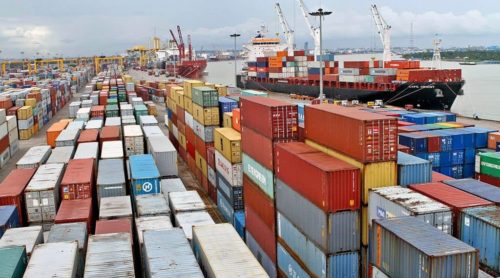Police Seize 400 Kilos of Cocaine from MSC Shipping Container

Container depot
(TME) Customs officials in Genoa, Italy have seized more than 400 kilos of cocaine from a shipping container from Brazil, a haul valued at more than $34 million.
The container arrived aboard the boxship MSC Adelaide on a voyage from Brazil. The drugs were stowed in 14 bags in the container, and authorities made the bust as a dockworker with the Compagnia Unica Lavoratori Merci Varie (CULMV) union was picking up the stash, according to local media.
A sailor was found with his throat cut on the same ship on Monday, according to local police. Investigators have not excluded the possibility that the death may have been a suicide, and they do not believe that the drug bust and the fatality are connected.
The drugs in the shipment are believed to come from Brazil, and though the specific port of origin was not disclosed, MSC Adelaide previously called at Santos – a critical hub for cocaine exports for drugs produced in Bolivia. According to Insight Crime, Santos’ drug trade is controlled by the Primeiro Comando da Capital (PCC) gang, which has regional connections for transporting Bolivian drugs through Paraguay and into Brazil, where it is exported from Santos in containers of ordinary goods. The degree of narco-trafficker infiltration at the port complex is so extensive that MSC – which is trying to reduce trafficking in its commercial cargo – has decided to drop pre-stacking and container-stuffing services in Santos.
Sunday’s drug bust was also the second time in two weeks that officials have intercepted cocaine bound for Genoa. On January 27, officials in Colombia seized nearly 20,000 coconuts filled with liquid (dissolved) cocaine in a container at the Port of Cartagena. The water inside the coconuts had been drained out and replaced with the drug-bearing liquid. Lab analysis is under way to estimate the dry-powder quantity of cocaine in the shipment. Cocaine is sometimes smuggled in a dissolved form in order to disguise it, as the fluid is less conspicuous than bags or bricks of white powder.
*Culled from The Maritime Executive.
The container arrived aboard the boxship MSC Adelaide on a voyage from Brazil. The drugs were stowed in 14 bags in the container, and authorities made the bust as a dockworker with the Compagnia Unica Lavoratori Merci Varie (CULMV) union was picking up the stash, according to local media.
A sailor was found with his throat cut on the same ship on Monday, according to local police. Investigators have not excluded the possibility that the death may have been a suicide, and they do not believe that the drug bust and the fatality are connected.
The drugs in the shipment are believed to come from Brazil, and though the specific port of origin was not disclosed, MSC Adelaide previously called at Santos – a critical hub for cocaine exports for drugs produced in Bolivia. According to Insight Crime, Santos’ drug trade is controlled by the Primeiro Comando da Capital (PCC) gang, which has regional connections for transporting Bolivian drugs through Paraguay and into Brazil, where it is exported from Santos in containers of ordinary goods. The degree of narco-trafficker infiltration at the port complex is so extensive that MSC – which is trying to reduce trafficking in its commercial cargo – has decided to drop pre-stacking and container-stuffing services in Santos.
Sunday’s drug bust was also the second time in two weeks that officials have intercepted cocaine bound for Genoa. On January 27, officials in Colombia seized nearly 20,000 coconuts filled with liquid (dissolved) cocaine in a container at the Port of Cartagena. The water inside the coconuts had been drained out and replaced with the drug-bearing liquid. Lab analysis is under way to estimate the dry-powder quantity of cocaine in the shipment. Cocaine is sometimes smuggled in a dissolved form in order to disguise it, as the fluid is less conspicuous than bags or bricks of white powder.
*Culled from The Maritime Executive.





